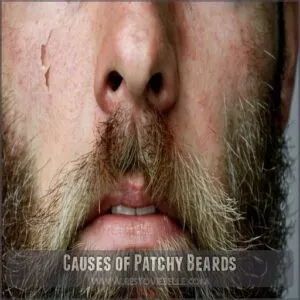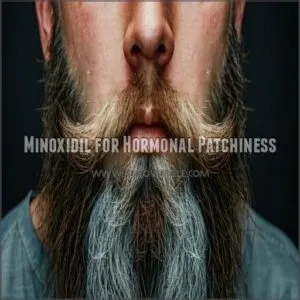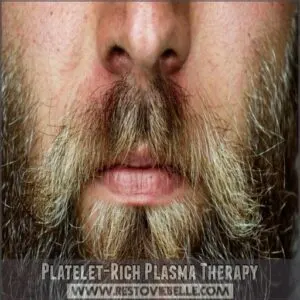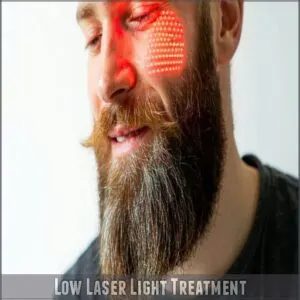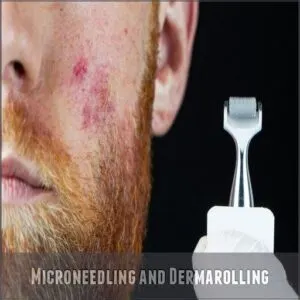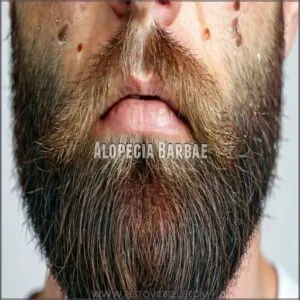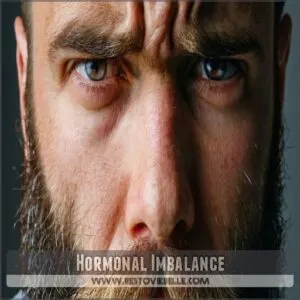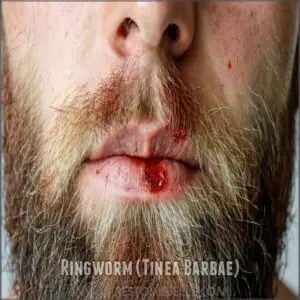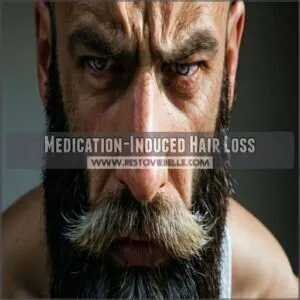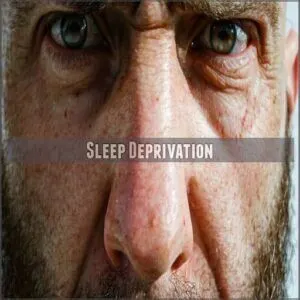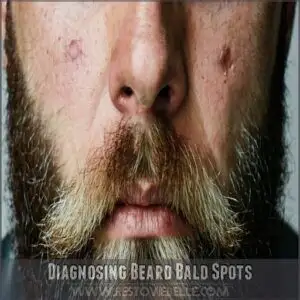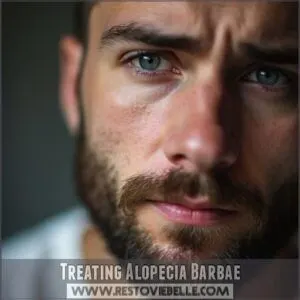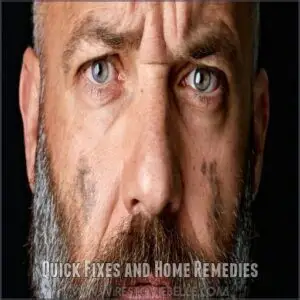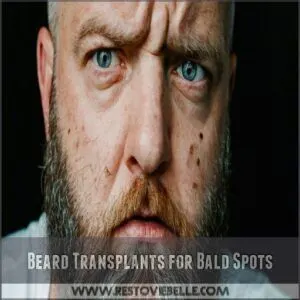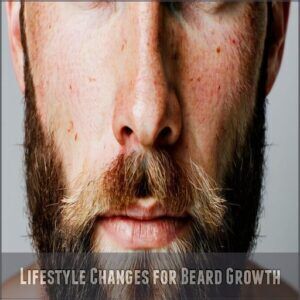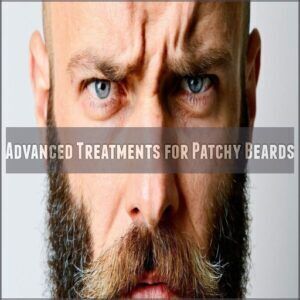This site is supported by our readers. We may earn a commission, at no cost to you, if you purchase through links.
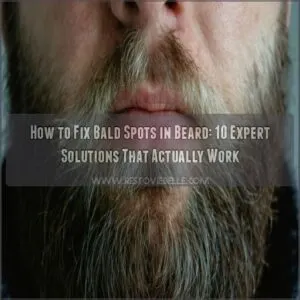
Start with minoxidil to boost hair growth, or consider platelet-rich plasma therapy for a more luxurious option.
Sometimes, those bald patches just need a little extra TLC with a healthy diet—think nuts, fish, and leafy greens to nourish your follicles.
Regularly washing and conditioning with a mild shampoo keeps dirt at bay and beard oils hydrate those strands.
Stress less, exercise more, and make sure you’re getting enough shut-eye.
Styling tricks, like careful trimming, can mask patchy areas too.
Want the full scoop? We’ve got you covered!
Table Of Contents
- Key Takeaways
- Causes of Patchy Beards
- How to Fix Bald Spots in Beard
- Types of Beard Bald Spots
- Diagnosing Beard Bald Spots
- Treating Alopecia Barbae
- Quick Fixes and Home Remedies
- Maintaining a Healthy Beard
- Beard Transplants for Bald Spots
- Lifestyle Changes for Beard Growth
- Advanced Treatments for Patchy Beards
- Frequently Asked Questions (FAQs)
- How to fix a bald spot on a beard?
- Is there a cure for balding?
- What causes a bald spot in your beard?
- How to hide a bald beard?
- How do you treat hair loss on a beard?
- What is a good treatment for a patchy beard?
- Is there a way to fix bald spots in a beard?
- Do beard bald spots fill in?
- Can you regrow a patchy beard?
- Can a patchy beard be fixed by shaving?
- How long does minoxidil take to work?
- Can certain foods improve beard health?
- Are beard oils beneficial for growth?
- Does genetics affect beard bald spots?
- Is stress a factor in beard loss?
- Conclusion
Key Takeaways
- Start with using minoxidil for stimulation and consider platelet-rich plasma therapy for a more comprehensive approach to beard growth.
- Ensure a healthy diet rich in nuts, fish, and leafy greens to nourish your hair follicles, alongside regular washing and conditioning to maintain beard health.
- Manage stress, exercise regularly, and get adequate sleep to promote a fuller beard and reduce patchiness.
- To address beard bald spots effectively, understanding the underlying causes such as alopecia barbae symptoms, is crucial. Explore quick fixes like beard dyes or styling techniques to temporarily cover bald spots while nurturing long-term growth through healthy habits.
Causes of Patchy Beards
You’re not alone if you’ve noticed those frustrating patches in your beard growth, as genetics and hormone levels play the biggest roles in facial hair patterns.
While you can’t change your DNA, you’ll be happy to know that many common causes of patchy beards, from low testosterone to poor circulation, can actually be fixed with the right approach.
Hormonal Influence on Beard Growth
Your beard’s growth is like a garden – it needs the right hormones to flourish.
Testosterone and DHT are the key players here, working together to stimulate your facial hair follicles.
If you’re dealing with patchy spots, low levels of these hormones might be the culprit.
Your genetics also play a role by determining how sensitive your follicles are to these hormonal signals.
Age matters too – most men see their best beard growth between 25-35.
Autoimmune Conditions
Imagine watching helplessly as mysterious bald patches appear in your beard – that’s the reality of alopecia areata, an autoimmune condition where your immune system attacks hair follicles.
While it affects 2 in 100 people, understanding is key to managing it.
You can explore a range of products for alopecia areata treatment to help address these issues.
Key impacts on your beard:
- Circular, smooth patches of hair loss
- Unpredictable pattern of regrowth and loss
- Potential psychological effects on confidence
Don’t worry though – it’s not contagious, and several treatment options exist.
Medical Conditions and Medications
Certain medications and health conditions can wreak havoc on your beard growth.
Cancer treatments like chemotherapy often cause temporary hair loss, while some blood pressure medications might thin your facial hair.
Autoimmune disorders, particularly alopecia areata (also called alopecia barbae when it affects your beard), can create circular bald patches.
In rare cases, fungal infections like tinea barbae might trigger patchy growth.
Poor Diet and Lifestyle Choices
Life’s daily grind can take a toll on your beard’s fullness.
When your body lacks essential nutrients and deals with constant stress, it shows in patchy facial hair.
Here’s what might be sabotaging your beard growth:
- Skipping meals or following crash diets
- Chronic stress that spikes cortisol levels
- Less than 7 hours of sleep per night
- Heavy alcohol consumption and dehydration
These factors disrupt hormone production and weaken hair follicles.
How to Fix Bald Spots in Beard
You’re not alone if you’ve noticed those pesky bald patches in your beard growth.
From proven treatments like minoxidil to natural solutions like derma rolling and lifestyle changes, you’ll find science-backed methods that can help transform your patchy beard into the full, magnificent growth you’ve always wanted.
Minoxidil for Hormonal Patchiness
Struggling with a patchy beard? Minoxidil might be your secret weapon.
This FDA-approved medication, originally used for blood pressure, works wonders for beard growth by increasing blood flow to hair follicles, which is also a key benefit of using derma rollers for growth.
Apply a 5% solution twice daily for at least 4 hours each time.
While results vary, most guys see noticeable improvement within 3-6 months of consistent use.
Platelet-Rich Plasma Therapy
PRP therapy can complement beard growth supplements to kickstart beard growth in patchy areas, harnessing your body’s natural healing powers to kickstart beard growth in patchy areas.
By injecting platelet-rich plasma directly into your facial hair zones, you’re giving those stubborn spots a fighting chance.
Here’s what you can expect from PRP:
- Results typically show within 3-6 months
- Treatment sessions last about 30 minutes
- Minimal downtime and natural-looking results
- Works best when combined with proper beard care
Low Laser Light Treatment
After seeing success with PRP, many guys turn to Low-Level Light Therapy (LLLT) for their patchy beards.
This FDA-cleared treatment uses red light wavelengths to wake up sleeping hair follicles.
Some users also combine LLLT with rogaine cream as a minoxidil alternative solution.
Here’s what you need to know about LLLT:
| Treatment | Time Investment | Cost Range |
|---|---|---|
| At-Home Device | 15 min/day | $200-600 |
| Clinic Sessions | 30 min/week | $75-150/session |
| Hybrid Approach | Varies | $400-800 total |
You’ll need consistency – think 3-6 months – to see real results.
Microneedling and Dermarolling
Microneedling with a derma roller can dramatically boost your beard growth by creating tiny channels in your skin that stimulate collagen production and follicle regeneration.
Going beyond laser treatments, this technique works wonders for those stubborn patches.
- Use a 0.5mm roller for weekly sessions to maximize results without causing irritation
- Always sterilize your derma roller before and after use
- Gently roll in multiple directions, but don’t apply excessive pressure
Healthy Diet and Lifestyle Choices
Your lifestyle choices can make or break your beard game.
Focus on getting 7-8 hours of quality sleep, managing stress through meditation or exercise, and eating a balanced diet rich in biotin, vitamins D and E.
Don’t skip the protein – aim for 0.8g per pound of body weight.
Consider supplements like L-Carnitine L-Tartrate and a multivitamin to support healthy beard growth.
Types of Beard Bald Spots
You’ll find different types of beard bald spots, from hormone-related patches to those caused by autoimmune conditions like alopecia barbae.
Whether you’re dealing with a few small spots or larger patches, understanding the specific type affecting your beard is the first step to finding the right treatment that’ll work for you.
Alopecia Barbae
Living with alopecia barbae feels like playing whack-a-mole with your facial hair – patches appear randomly, often without warning.
This autoimmune condition occurs when your immune system mistakenly attacks hair follicles, creating smooth, round bald spots in your beard.
- The initial signs often appear as coin-sized circular patches
- Patches can multiply and merge over time
- Some spots may feel tingly or slightly irritated
- About 60% of cases resolve within a year
Hormonal Imbalance
A hormonal imbalance can wreak havoc on your beard growth pattern, often leading to those frustrating patchy spots.
Here’s what you need to know about key hormones affecting your facial hair:
| Hormone | Impact | Solution |
|---|---|---|
| Testosterone | Drives follicle growth | Exercise, zinc-rich foods |
| DHT | Thickens beard hair | Natural DHT boosters |
| Thyroid | Controls hair cycles | Medical check-up |
| Cortisol | Blocks growth when high | Stress management |
| Growth Hormone | Repairs follicles | Quality sleep |
Ringworm (Tinea Barbae)
Unlike hormonal issues, ringworm (tinea barbae) creates circular bald patches in your beard that often itch and burn. This fungal infection loves warm, moist environments and can spread through shared razors or towels.
- Red, scaly rings appear on your skin, making you feel self-conscious
- Intense itching drives you crazy throughout the day
- Painful, burning sensation makes shaving impossible
- Spreading patches cause anxiety about social interactions
A doctor can diagnose this condition and prescribe antifungal medication to clear it up quickly.
Medication-Induced Hair Loss
Certain medications can trigger unexpected beard bald spots as a side effect.
Here’s what you need to know about common hair loss triggers and their impact on your facial hair:
| Medication Type | Impact on Beard | Recovery Timeline |
|---|---|---|
| Chemotherapy | Complete loss | 3-6 months |
| Acne medications | Patchy thinning | 1-3 months |
| Blood pressure drugs | Gradual thinning | 2-4 weeks |
| Anticoagulants | Spotty patches | Variable |
Talk to your doctor about adjusting dosages or switching medications if you notice beard thinning.
Most medication-induced hair loss is temporary and reverses once treatment ends.
Sleep Deprivation
Your sleepless nights might be sabotaging your beard game more than you realize.
Poor sleep disrupts growth hormones and testosterone production, which are vital for healthy beard growth.
Consider using a beard sleep aid supplement to help promote better sleep and beard health.
When you’re not catching enough z’s, your body’s natural hair cycle gets thrown off balance, leading to patchy spots and thinning.
Think of sleep as your beard’s secret weapon – it’s working overtime while you’re dreaming away.
Diagnosing Beard Bald Spots
You’ll need to play detective with your beard to figure out what’s causing those frustrating bald patches.
Whether it’s a sudden case of missing whiskers or a gradually thinning beard, understanding the pattern of your hair loss is the first step toward bringing back your facial glory.
Sudden Vs Chronic Hair Loss
So, you’re noticing those pesky beard bald spots and wondering if they’re just a flash-in-the-pan or something more stubborn?
Sudden hair loss might hint at stress, medication effects, or other temporary hiccups.
Chronic beard patchiness, though, could point to ongoing issues like genetics or aging.
Pinning down the cause helps steer your beard regrowth journey.
Patch Shape and Size
When sizing up beard bald spots, notice if those patches are round, irregular, or mismatched.
Patch shape and size can reveal underlying causes.
Round, symmetrical patches might mean alopecia areata, while uneven patches could hint at grooming habits.
Location matters—chin or cheeks?
Understanding these can guide you in choosing effective treatments for encouraging beard regrowth and achieving patch density.
Facial Rash and Inflammation
Facial rash and inflammation can throw a wrench in your beard growth plans, often leaving you scratching your head—and your chin.
Understanding triggers is key:
- Allergies: Harsh products can irritate.
- Hygiene: Keep it clean to avoid flare-ups.
- Diet: Balanced nutrition reduces rashes.
Tackle these to smooth the path for a fuller, itch-free beard.
Medical History and Medication Review
Got some beard bald spots? Digging into your medical history could unearth clues.
Medications may have sneaky side effects impacting growth, while underlying health conditions like alopecia barbae could play a role.
Don’t forget past treatments, family history, and any recent changes.
Consulting a doctor may lead to helpful solutions like minoxidil, derma rollers, or even considering a beard transplant if needed.
Treating Alopecia Barbae
If you’re battling alopecia barbae and seeing frustrating bald patches in your beard, don’t worry, there are proven ways to tackle this.
Corticosteroids, minoxidil, and Vitamin E supplements offer options to take charge of your beard growth journey—and maybe rescue a few bad hair days. Additionally, biotin plays a significant role in keratin production, which is essential for maintaining healthy beard growth, and taking supplements with biotin can support this process, especially for those with a biotin deficiency condition, and maybe rescue a few bad hair days!
Corticosteroids for Alopecia Barbae
Experiencing beard thinning can make you feel like someone’s stolen the spotlight from your grooming game.
Corticosteroids are a go-to for battling alopecia barbae, helping calm inflammation and encouraging beard hair regrowth.
Whether used topically or injected, these meds enhance beard hair strength.
Though effective, be mindful of side effects like skin thinning.
Always consider dosage and duration with your doctor’s guidance.
Minoxidil for Alopecia Barbae
Struggling with alopecia barbae? Minoxidil might be your secret weapon.
This topical solution, applied twice daily, can stimulate hair growth by improving blood flow to hair follicles, similar to how Redensyl vs Minoxidil treatments work differently but still achieve hair growth.
But remember these three things:
- Start with a low Minoxidil dosage.
- Watch for side effects like irritation.
- Long-term use requires a doctor’s guidance.
Used correctly, minoxidil can help you regain a fuller beard. It’s a journey, not a sprint, so be patient!
Vitamin E Supplements for Alopecia Areata
While minoxidil might work wonders for some, don’t overlook the benefits of Vitamin E supplements for tackling alopecia areata.
Research suggests that Vitamin E can aid in promoting beard growth by fighting oxidative stress.
However, keep an eye on your dosage to avoid side effects.
Picture it as your beard’s personal bodyguard against bald spots—a little extra protection never hurts!
Quick Fixes and Home Remedies
If you’re tired of those pesky bald spots in your beard, quick fixes and home remedies might be just what you need to save the day.
From hair fibers to a bit of strategic dyeing, there’s no shortage of clever tricks to make your facial hair look fuller and more fabulous.
Hair Fibers and Thickening Sprays
For a quick fix to bald spots, hair fibers and thickening sprays can be your go-to trick.
These solutions attach to existing hairs, creating the illusion of a fuller beard.
It’s like a magic wand for facial fuzz, offering temporary coverage.
Compare brands for the best results and natural look.
Remember, though, these won’t stimulate growth—just disguise thin areas brilliantly.
Beard Micropigmentation
Tired of trying sprays.
Beard micropigmentation might be your magic wand.
This procedure fills beard bald spots, often caused by conditions like alopecia barbae treatment, by tattooing tiny dots that mimic hair.
Think of it as a permanent beard filler without the daily hassle.
If you’re curious about costs, you can find various options for beard micropigmentation cost.
Costs vary, but compared to microblading, it’s a game-changer.
Just beware of risks like infection and uneven dye, and always check those "before and after" shots.
Vitamin E Supplements for Beard Growth
Looking for a natural boost for that scruffy beard?
Enter Vitamin E, your follicle’s new best friend.
Known for its antioxidant magic, Vitamin E bolsters beard growth by promoting hair follicle stimulation.
Unlike minoxidil, it’s a gentler option with fewer side effects.
Balance is key—stick to recommended doses to avoid issues.
Try Vitamin E oil directly or opt for supplements for consistent growth.
Dyeing The Beard a Shade Darker
Dyeing your beard a shade darker can offer an instant fix for patchy areas.
When selecting a color, match your natural hair color for a seamless look, consider henna-based dyes. Choosing the right color matching is key—opt for reputable beard dye brands.
Decide between temporary and permanent options based on your commitment level.
Maintenance is key, so follow tips to keep the color vibrant without harming beard follicles.
A clever trick for subtle beard growth enhancement!
Maintaining a Healthy Beard
You’ll want to focus on a healthy lifestyle to promote strong beard growth.
This includes eating well, managing stress, and getting enough sleep.
Think of it as a spa day for your facial follicles!
Preventing Beard Bald Spots
Managing stress and maintaining a balanced diet are key to preventing beard bald spots.
Picture your beard as a garden; without proper nutrition and care, patches can appear.
Incorporate a solid hair care routine with quality beard oil or balm.
Remember, genetics do play a role, but lifestyle factors like exercise and good sleep are in your control, boosting beard health effectively.
Promoting Beard Growth
Discovering the secrets of promoting beard growth isn’t rocket science—it just takes a bit of know-how.
Regularly massaging your beard with essential oils ramps up follicle stimulation, boosting the hair growth cycle.
Using top beard growth products can also stimulate hair growth and strengthen your beard.
Beard oils and serums target bald spots, working wonders on patchiness.
Don’t forget beard supplements for that much-needed nutritional punch, turning your stubble struggles into a grooming success story.
Managing Stress and Sleep Deprivation
Feeling stressed out isn’t just bad for your mood—it hits your beard growth too.
Stress management techniques like mindful breathing exercises and relaxation methods can help toss those worries.
Prioritize sleep hygiene tips to combat sleep deprivation.
Think of it as a spa day for your scalp!
After all, anxiety reduction strategies and good sleep are essential for keeping those beard follicles stimulated.
Maintaining a Balanced Diet
A balanced diet can transform your beard from blah to wow.
Boost beard growth with foods high in testosterone-enhancing nutrients like oysters and olive oil.
Scoop up seeds and nuts for essential vitamins.
With every bite, you’ll be stimulating those beard follicles.
Remember, your beard’s not just fed by genetics—it’s also served by your plate!
Beard Transplants for Bald Spots
If you’re tired of bald spots and wish your beard matched your lumberjack dreams, consider a beard transplant.
This procedure can effectively fill in those stubborn gaps.
And with improved techniques, it’s now more accessible and successful than ever.
Effectiveness of Beard Transplants
Getting a healthy beard starts with knowing what works. Beard transplants can move hair to fill patches, but are they worth it?
- Cost: They can be pricey; think of it like a luxury spa day.
- Success Rate: Pretty high if you’re the right candidate.
- Long-term Results: Generally good, but expect some initial scarring.
Eligibility and Suitability
So, you’ve weighed the pros and cons of beard transplants.
Now, let’s see if you’re a good candidate.
Factors like your age, overall health, and budget play a role.
Realistic expectations are key—it’s not a magic bullet.
Are you ready for the time commitment involved?
A consultation will determine if a beard transplant is right for you.
Consultation and Procedure
When considering a beard transplant, booking a consultation is the first step.
Here, you’ll learn about procedure risks, get a cost estimate, and discuss recovery timelines.
Ask about post-procedure care to maximize results.
This isn’t just a quick fix; it’s about stimulating those lazy follicles.
Plus, ditching patchiness for a fuller beard feels like a win!
Before and After Photos
You’ve explored the consultation stage; now feast your eyes on before and after photos.
Witness real results with hair transplants transforming patchy beards into lush landscapes.
Personal stories showcase incredible beard growth timelines, proving that stubborn beard hair loss isn’t unbeatable.
By addressing underlying issues such as alopecia barbae through treatments like minoxidil for alopecia, these images reveal how stimulating beard follicles and using growth serums can truly revive your beard’s potential, making inspiration just a glance away.
Lifestyle Changes for Beard Growth
Want to boost your beard growth and fill in those pesky bald spots?
Making simple lifestyle changes , like exercising regularly, reducing stress, getting enough sleep, and eating a balanced diet, can substantially help foster healthier facial hair, without needing to spend a fortune on fancy products.
Exercise and Physical Activity
Regular exercise, like strength training and cardio, can boost testosterone and improve blood flow, impacting beard growth and density.
Think of it as a workout routine for those patchy spots.
By increasing circulation, physical activity helps nourish follicles, potentially thickening your beard.
Embrace exercise benefits to transform patchiness into a fuller, healthier facial masterpiece.
Reducing Stress and Anxiety
Managing stress and anxiety plays a key role in fostering beard growth, as research shows that anxiety can cause hair loss through the influence of stress hormones.
Picture stress management techniques like mindfulness practices or relaxation exercises as your trusty toolkit, particularly in helping to combat stress-related hair loss issues such as telogen effluvium or alopecia areata other anxiety-related hair loss conditions.
They’re here to aid beard follicle stimulation and combat beard hair loss.
Employ these healthy coping mechanisms and anxiety reduction strategies to smooth your path to a fuller beard, with a sprinkle of calm in your life.
Getting Enough Sleep
While you mightn’t see sleep as a beauty routine, ignoring sleep hygiene can turn beard care into a wild goose chase.
Solid sleep duration and quality boosts testosterone in your body, stimulating those lazy beard follicles.
So, don’t let sleep deprivation derail your efforts.
Aim for restful, uninterrupted sleep, like a cozy lullaby for your beard.
Eating a Balanced Diet
Sleep’s important, but a good diet fuels beard growth too!
Think of your beard like a finely tuned sports car—it needs the right fuel.
Here’s what to add to your plate for a thicker, fuller beard:
- Oysters (zinc!)
- Sweet potatoes (beta-carotene)
- Spinach (iron)
- Eggs (protein)
- Nuts (healthy fats)
A nutrient-rich beard diet is key for amazing results.
Advanced Treatments for Patchy Beards
If you’ve tried the basics and your beard still resembles a patchy quilt, it’s time to explore advanced treatments.
Options like hormone therapy, low-level laser therapy, and platelet-rich plasma therapy offer scientifically-backed ways to promote fuller beard growth.
Because sometimes patience and good shaving cream just aren’t enough.
Hormone Therapy for Beard Growth
Boosting testosterone and DHT levels through hormone therapy might just be the ticket for filling those stubborn beard patches.
Imagine harnessing the power of hormone replacement therapy to awaken your inner Viking!
But remember, tread carefully—side effects can be a sneaky companion, and it’s wise to ponder the long-term impact.
Consider consulting your doctor before embracing this hairy adventure.
Low-Level Laser Therapy (LLLT)
Curious about a hair growth boost? Low-Level Laser Therapy (LLLT) might be your answer.
Offering a non-invasive fix for patchy spots, LLLT’s known for:
- Stimulating hair follicles with laser light.
- Being a safe choice, minus the scalpel.
- Suiting most hair types with LLLT devices.
- Providing a painless alternative to serums.
Embrace your beard journey with a laser edge!
Platelet-Rich Plasma (PRP) Therapy
Platelet-Rich Plasma (PRP) Therapy might sound like science fiction, but it’s here to give your beard that extra oomph! By injecting your own plasma into bald spots, you boost hair regrowth naturally.
Curious about the nitty-gritty? Here’s a cheat sheet:
| Aspect | Detail |
|---|---|
| Cost | Usually $500-$1500 |
| Risks | Minimal, mild discomfort |
| Benefits | Promotes natural beard growth |
| Results | Visible in 3-6 months |
| PRP vs Minoxidil | PRP uses your own cells |
Frequently Asked Questions (FAQs)
How to fix a bald spot on a beard?
Want a fuller beard? Don’t despair! Try minoxidil, microneedling, or even a beard dye. These methods can often help fill in those pesky bald spots. Consistent use is key!
Is there a cure for balding?
There’s no outright cure for baldness, but treatments like minoxidil, finasteride, and hair transplants can slow it down or restore hair.
Embrace the change, explore these options, and consult a dermatologist for personalized advice.
What causes a bald spot in your beard?
Bald spots in your beard can pop up due to genetics, hormone levels, stress, or conditions like alopecia areata.
Even lifestyle factors, like poor nutrition or lack of sleep, can play a role in hair loss.
How to hide a bald beard?
Trim your beard evenly, making it look fuller, or consider dyeing it a shade darker.
Embrace styles like the goatee or Balbo to cleverly conceal patches while adding a touch of flair to your look.
How do you treat hair loss on a beard?
To treat beard hair loss, try minoxidil for growth stimulation, derma rolling to boost blood flow, and a balanced diet.
Consistent use over time, paired with good sleep and stress management, can enhance results.
What is a good treatment for a patchy beard?
Wondering if it’ll work? Try minoxidil to encourage hair growth, microneedling for follicle stimulation, and a balanced diet rich in DHT-boosting nutrients.
Regular exercise and adequate sleep can also support healthier, fuller beard growth.
Is there a way to fix bald spots in a beard?
Tackle bald spots in your beard by trying minoxidil to boost growth, using derma rollers to awaken follicles, or adjusting your diet to improve health.
These methods enhance blood flow and hormone levels, encouraging a fuller beard.
Do beard bald spots fill in?
Like a stubborn weed, some beard spots stubbornly refuse to fill in.
However, many do! Patience is key; consistent healthy habits often yield results.
Time, proper nutrition, and potentially minoxidil can help.
Can you regrow a patchy beard?
Yes, you can regrow a patchy beard.
Try using minoxidil, derma rolling, and boosting testosterone with diet and exercise.
Maintain a healthy lifestyle, and consider strategic styling or beard dyes to enhance appearance as it grows.
Can a patchy beard be fixed by shaving?
Shaving doesn’t fix a patchy beard; it only offers a clean slate.
Embrace your unique style and experiment with different beard shapes.
Instead, consider nurturing hair growth with a healthy lifestyle, minoxidil, or derma rolling.
How long does minoxidil take to work?
Picture patience as your ally—minoxidil can start showing beard growth in three to six months.
Some folks notice changes sooner, while others need extra time, so keep at it faithfully for best results.
Happy growing!
Can certain foods improve beard health?
Eating foods rich in testosterone and DHT-boosting nutrients like sorghum, oysters, and olive oil can help improve beard health.
These foods support hormone production, potentially enhancing beard growth and filling in those patchy areas.
Are beard oils beneficial for growth?
Beard oils boost beard health by hydrating skin, reducing itch, and softening hair.
They don’t directly promote growth.
Regular application helps maintain a lush look, keeping your beard looking well-groomed and feeling fabulous.
Does genetics affect beard bald spots?
Your beard genetics can really throw a wrench in your plans for a full, luscious beard.
They influence hair growth patterns, determining thickness and density, often passing down those pesky bald spots from one generation to another.
Is stress a factor in beard loss?
Stress, my friend, can be a real beard-buster!
It messes with your hormones, impacting hair growth.
Manage stress levels for a fuller, healthier beard.
Think yoga, meditation, or a good scream into a pillow!
Conclusion
Fixing bald spots in your beard doesn’t need to be as challenging as understanding Morse code.
With plenty of modern solutions, like minoxidil or platelet-rich plasma therapy, you can encourage beard growth effectively.
A nutrient-rich diet, proper grooming, and staying stress-free also help.
From diagnosing issues to implementing effective treatments, you’re equipped with the knowledge to tackle patchiness head-on.
Embrace these expert tips, and those bald spots will soon be a thing of the past!

